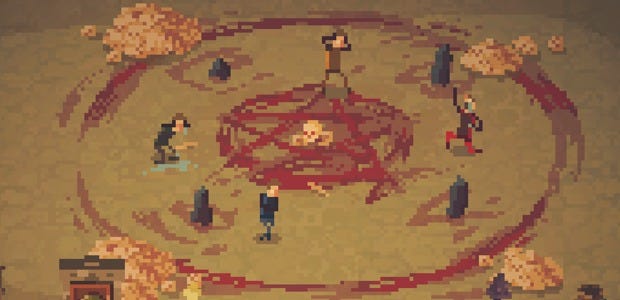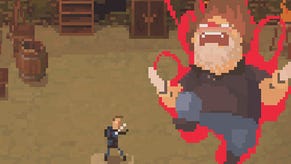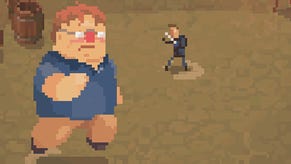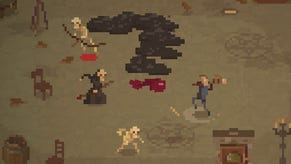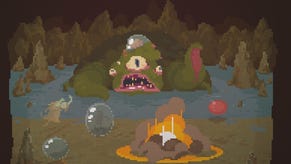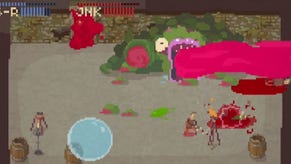How Crawl found the fun in unfairness
Tipping the balance
This is The Mechanic, where Alex Wiltshire invites developers to discuss the inner workings of their games. This time, Crawl [official site].
Crawl is a game about cooperation, betrayal and murder and accumulating enough eldritch power to kill a god. Made by Australian indie Powerhoof, it’s a couch multiplayer game played with up to three friends, but only one of you can be the hero. Everyone else is playing a monster, but when a monster kills the hero, it takes their place. This loop, of ganging up, competing to strike the final blow and then turning on your friends, captures the essential heart of the best local multiplayer games. It’s that delicious tension of power and powerlessness, of ruthlessness and submission, of laughter and jeering. At the centre of Crawl is a lovely bit of:
THE MECHANIC: Unfairness
“Yeah, as much as people will say something is unbalanced, the points in a local multiplayer game that are fun are always the points where things are unbalanced,” designer Barney Cummings tells me. “It’s when people say, ‘Holy shit, I’m the small guy,’ or, ‘Holy shit I’m overpowered and I’ve got a really good weapon against that monster, look at me taking him apart.’”
But inside Crawl rages a constant battle. For a couch multiplayer game, there’s an awful lot going on, its mechanics delicately weighing against and interlocking with the others to deal with the asymmetry that drives play. The need to regulate the constant cut and thrust of player success and failure, keeping things fun and preventing someone going off in a huff, has shaped and re-shaped the game throughout its four-year development, which finally reached official release earlier this month after a long spell in Early Access.
The basic setup is probably best understood through Crawl’s early history. It emerged from a game Cummings created for a multiplayer party, a concept that was the result of a misunderstanding and maybe a little laziness.
Someone had explained to Cummings The Binding of Isaac, “But I’m a bit embarrassed to admit that often a friend will explain something to me and I will misunderstand it and get a very different picture, but I’ll get quite attached to that and keep on building on it.” His idea of a game with Zelda-like dungeons turned out to be quite different to what Isaac is, but it chimed with an interest in making a four-player local multiplayer game set in a randomised dungeon. “And if I just got the other players to fill in for the monsters I would’t have to do all this AI programming that didn’t know how to do.”
The result was a game where one player is the hero and everyone else is a monster randomly chosen from a pool of creatures with differing abilities. Monster-players would have to waggle their stick to discover who was who, and then the killer of the hero got to become the hero.
Some monsters were more powerful than others, giving the asymmetry an extra edge, and some were weak, like a slime monster which had a very slow attack with a tiny hitbox. “So whenever someone spawned as it, everyone would be like, ‘What’s gonna happen, is he going to hit anything?’ And if you got a kill with it, everyone went bananas.”
If you fast-forward to the final game, you’ll find a lot of this asymmetry is ironed out. Today, players have just three monsters in the pool from which they’re randomly spawned, and as they play through the game their three monsters can be evolved to become more and more powerful and to gain new abilities.
“There are a lot of reasons why that’s good but you do lose a certain amount of the silly fun you got when it was random,” admits Cummings. But the change was necessary because players expect to be competing on a level playing field. While their moment-to-moment experiences might be fun, Powerhoof found frustration lay in being dealt a duff monster. “Because the game has that competitive element, people didn’t want monsters to be as extremely unbalanced as we wanted them. People play to a dominant technique so they just wouldn’t choose them.”
Wanting to maintain that magic in the original prototype, Powerhoof realised the answer was in making unfairness fleeting and unpredictable. Crawl’s imbalances aren’t easily repeatable and don’t last for long, so no one feels cowed or charmed for long.
Each player has a pool of three quite different monsters, so if the hero has gear that’s strong against a certain monster, you’ll have another on your roster that can turn the tables. Or if a certain monster is strong against the currently playing hero, when the hero falls the monsters will be facing a hero with different gear, potentially finding themselves at a disadvantage.
Still, in general, advantage has to be with the hero. Powerhoof’s general design pattern for monsters was of responsive attacks followed by a period of vulnerability, to give the hero a slight upper hand. If the monster gets the hit, then their attack is successful and they’ll probably avoid being damaged while vulnerable. If they miss, well, they took a risk and failed. “We were puzzling over stuff like that quite a bit, walking the line between them feeling clunky to play as and not being unfair to fight as,” says Cummings.
“We definitely discovered that making monsters simultaneously good to play against and as was challenging, and against the small monsters, in a lot of cases it was more interesting,” he continues. Powerhoof liked the combat dynamic created by low-health, low-level monsters because they were designed around defensive strategies, making for tactical battles where careful use of abilities counts, though they had to accede to player expectations of eventually evolving their monsters into powerful, straightforwardly aggressive brutes.
Beyond the monster design, Crawl’s grander mechanics also serve this notion of shifting powers. As a hero, your object is to raise your power by levelling up and buying weapons and equipment so you can successfully confront the boss, which is possible (but not advisable) once you reach level 10. XP for levelling up is earned by defeating monsters. But gold for buying gear is earned not when you’re a hero, but when you’re a monster. On the other side, monsters earn their own currency for levelling up, called wrath, when the hero levels up.
This interleaving of systems self-rights periods when one hero manages to survive for a while and raise their level up, since all that time the other players are happily earning gold which, once they become a hero, they’ll be able to immediately invest in good gear. Meanwhile, the other monsters are also earning so, once the hero decides to descend to the next level of the dungeon, they’ll be able to evolve, too.
The challenge, however, is that the system isn’t intuitive. Why would a monster be earning a currency that a hero spends? Why would a hero be earning a currency that a monster spends? Rewards are dislocated from their earning, and players had trouble understanding what’s going on. “Multiplayer is not a good environment to teach abstract rules,” he says. “Everyone’s just playing and no one wants to read a speech bubble.”
Powerhoof eventually decided to lay it out in a compulsory tutorial that starts when the game is played for the first time. But you don’t need to know precisely how it works to play. “Fortunately it’s a system that people basically understand enough. You don’t miss out on your chance to upgrade, even if you don’t exactly understand why you got that amount of gold.”
There’s yet another dimension to Crawl’s dance with unfairness and asymmetry. We’ve talked about players being heroes and monsters, but there’s a third state: the default state for a non-hero player is a ghost. They can only become monsters when the hero visits rooms in the dungeon for the first time. And once defeated as a monster, they go back to being a ghost.
As a ghost, you can’t directly hurt the hero. “But the problem with Crawl being multiplayer, the hero would go around smashing every scenery prop in the room, because it’s satisfying to smash them, and the ghosts would sit around, bored shitless.”
The solution came in two parts. First, ghosts can possess props and launch them in the hopes of hitting the hero, and that’s fun. And second, when a hero smashes props, it releases yet another currency called ectoplasm. Collect enough of that and a ghost can spawn blob enemies to attack the hero. It’s another example of a circular system of give and take, where heroes get to enjoy smashing stuff up and also prevent ghosts from hitting them with chairs, but in doing so end up giving ghosts the chance to summon extra enemies to attack them.
When laid out on a slab, Crawl looks an impossibly complex mess of progression systems all tangled up with each other. But in play, it works, whether you fully understand what’s happening or not. Its interlocking systems mean one side is always benefitting the other, even as it’s benefitting itself. The secret to Crawl is that in its brand of unfairness, everybody is always winning, whether they’re dominating or being dominated.
But only one player can win: the one who kills the boss. Here, the balance changes again, with competition among the monsters dissolving into cooperation to defeat the hero before they defeat the boss. Each of the game’s three bosses features different elements that the non-hero players can possess - a tentacle, a vast statue’s arm - to help crowd in and bash the hero. “The desired thing for us is three people yelling at each other, trying to coordinate,” says Cummings.
Yelling, in fact, is ultimately the barometer of a good couch multiplayer game. Yelling happens when one person wins and the other loses; it comes from friction and frustration, when your move speed is just that little bit too sluggish, where you die before you had a chance, where you roll the worst character. Fun isn’t about fair play, and Crawl knows all about it.
